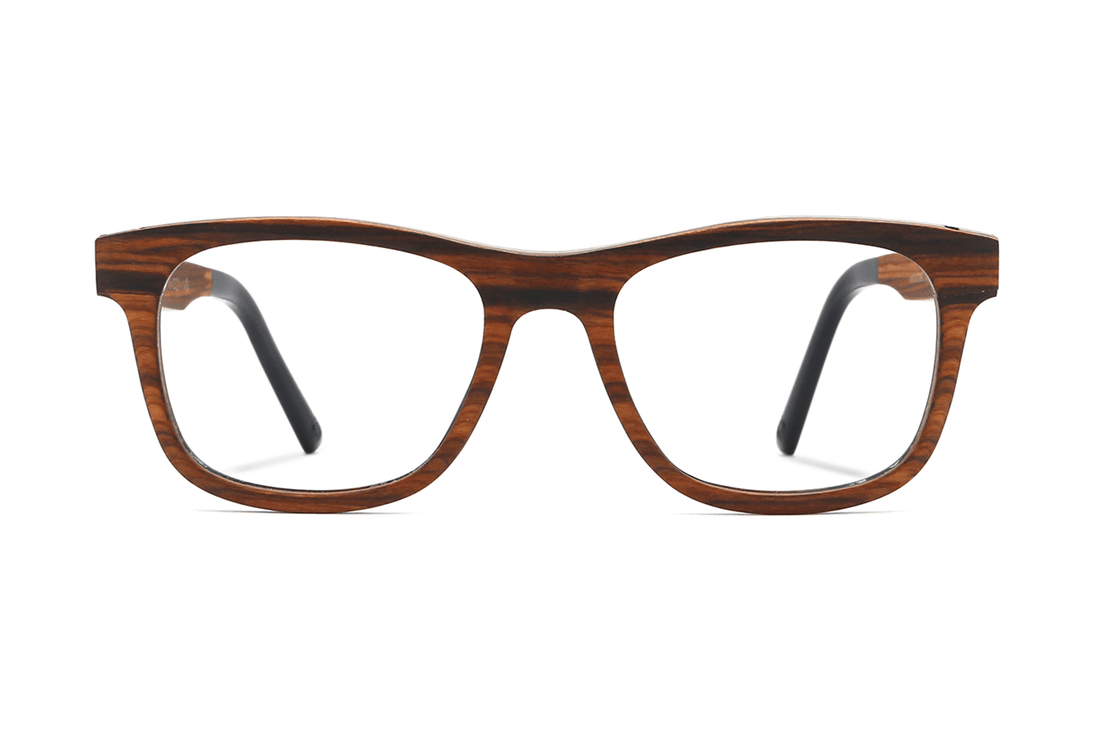
What Are Eco Friendly Glasses? A Complete Guide to Sustainable Eyewear Materials & Practices
What Are Eco Friendly Glasses?
8 min read • Updated on 29 December 2025
Eco friendly glasses are transforming the way people approach eyewear, blending style with conscious, low-impact materials and responsible production. As more shoppers shift toward environmentally mindful choices, sustainable eyewear offers a meaningful way to reduce waste without sacrificing comfort, durability, or design. These frames support a greener lifestyle while giving you the quality and performance you expect from everyday glasses.
New to sustainable and eco-friendly eyewear? This guide is your fast track to eco-friendly glasses inspiration.
Here’s what this guide will cover:
-
What makes glasses truly eco friendly
-
How sustainable manufacturing reduces environmental impact
-
Key materials used in eco eyewear
-
The role of packaging in sustainability
-
How brands like Kraywoods balance style and responsibility
What Makes Eyewear Truly Eco Friendly?
Eco friendly glasses are designed using materials and production methods that significantly reduce environmental impact while maintaining durability, comfort, and style. Unlike traditional eyewear made with petroleum-based plastics and chemical-heavy processes, sustainable glasses prioritize renewable, recycled, or biodegradable components paired with ethical, low-waste manufacturing.
Sustainable Sourcing
Eco eyewear materials come from responsibly managed or renewable sources, such as bio-acetate, recycled metals, reclaimed plastics, or sustainably harvested woods. These alternatives lower dependency on virgin plastics and minimize harmful waste.
Reduced Environmental Impact
Eco friendly glasses reduce envirnmental impact being produced with fewer toxins, less water consumption, and reduced emissions. Many brands adopt cleaner energy, use natural dyes, and limit chemical treatments to create a more environmentally conscious product.
Ethical & Transparent Production
Sustainable eyewear brands focus on fair labor practices, transparent supply chains, and environmentally responsible manufacturing partners. This ensures the entire process — from raw material to finished frame — supports people and the planet.
How Eco-Friendly Glasses Differ From Regular Glasses
Traditional glasses rely on petroleum-based acetate, chemical adhesives, and high-emission production. Eco friendly glasses use renewable or recycled materials, low-waste systems, and earth-friendly components that support long-term sustainability without compromising style or performance. Get more insights on the shift sustainable eyewear is making in Eyeing Environmental Sustainability: How the Eyewear Industry Is Revolutionizing Its Practices.
How Sustainable Eyewear Is Made
Eco friendly glasses are shaped not only by their materials but by the way they’re made. Sustainable manufacturing focuses on reducing waste, lowering emissions, and creating eyewear through processes that respect both people and the planet. These practices ensure that every step — from shaping frames to final assembly — is part of a circular economy that contributes to a cleaner, more responsible fashion ecosystem.
Energy-Efficient Production
Many sustainable eyewear makers use lower-emission machinery, cleaner energy sources, or more efficient production cycles. This reduces the carbon footprint typically associated with acetate production and plastic molding.
Low-Waste & Closed-Loop Systems
Eco responsible manufacturers collect, reuse, or repurpose production scraps to prevent excess waste. Recycled acetate sheets, reclaimed metals, and re-melted plastics help create new frames without relying on virgin materials. Some manufacturers follow a closed-loop system, where leftover materials are continuously reintegrated.
Ethical Labor & Transparent Supply Chains
True sustainability includes fair labor conditions. Many eco conscious eyewear brands work with partners who prioritize worker safety, transparent sourcing, and environmentally responsible standards.
Materials That Define Eco-Friendly Glasses
Eco friendly glasses rely on innovative, responsibly sourced materials that reduce environmental impact without compromising durability or design. These materials replace traditional petroleum-based plastics with renewable, recyclable, or biodegradable alternatives.
Recycled Plastics & Metals
Recycled materials give new life to existing resources. Recycled plastics are reprocessed into sturdy acetate-like sheets, while recycled metals — such as stainless steel or aluminum — are melted down and reshaped into long-lasting frame components. These materials help reduce landfill waste and replace the need for virgin plastic production.
Biodegradable Acetate
Biodegradable acetate, often called bio-acetate, is made from natural plant fibers like cotton or wood pulp. Unlike traditional acetate, which relies on petroleum-based chemicals, bio-acetate breaks down more safely over time and contains fewer harmful additives. It creates frames that are flexible, durable, and available in a wide range of colors.
Sustainably Sourced Wood
Wooden eyewear uses responsibly harvested hardwoods such as ebony, walnut, cherry, and bamboo. These materials offer a lightweight feel, organic texture, and natural warmth. Wood frames are crafted through low-waste processes and finished with non-toxic treatments, making them a renewable and environmentally conscious choice.
Sustainable Packaging & Accessories That Reduce Waste
Sustainability extends beyond the frames themselves. Eco friendly glasses often come with thoughtfully designed packaging and accessories that minimize waste and reduce environmental impact.
Minimal, Recyclable Packaging
Brands committed to sustainability use streamlined packaging made from recyclable cardboard, compostable materials, or low-ink printing. These choices reduce unnecessary waste while protecting the eyewear during shipping.
Eco-Friendly Cases & Cleaning Cloths
Protective cases made from natural fibers, recycled materials, or sustainably sourced wood offer durable storage without relying on synthetic plastics. Cleaning cloths may also be produced from recycled microfiber or low-impact textiles.
The Role of Responsible Packaging
Responsible packaging is an important part of reducing a product’s overall footprint. By choosing recyclable, reusable, or compostable components, brands support a more circular approach to eyewear and reduce single-use waste at every stage of the customer experience.
Read more about the impact of sustainable eyewear on the environment and the eyewear industry in our curated guide on Why Sustainable Eyewear Matters in 2026.
Stylish Eco-Friendly Glasses for Modern Wearers
Eco friendly glasses prove that sustainability and great design can coexist effortlessly. Today’s sustainable eyewear blends timeless aesthetics with lower-impact materials, giving you frames that feel as good as they look.
Classic Shapes with Modern Eco Materials
From square and round frames to cat-eye and geometric silhouettes, iconic eyewear styles are now crafted using bio-acetate, recycled metals, or sustainably sourced woods. These materials allow brands to recreate popular designs with a lighter environmental footprint.
Natural Dyes & Low-Impact Finishes
Eco friendly glasses often use natural dyes, water-based finishes, or low-chemical treatments to achieve rich colors and smooth textures. This results in a polished, premium look without the environmental impact of traditional plastics and coatings.
Why Choose Kraywoods
Kraywoods blends style, responsible materials, and craftsmanship by using sustainably sourced wood, plant-based acetate, and ethical production methods. Our designs combine modern silhouettes with eco-conscious values, giving you durable, stylish eyewear that supports greener fashion choices.
FAQs About Eco Friendly Glasses
What makes glasses eco friendly?
Eco friendly glasses are made from renewable, recycled, or biodegradable materials and produced through low-waste, ethical, and energy-efficient processes. They reduce environmental impact while offering the same durability and comfort as traditional eyewear.
Are eco friendly glasses durable?
Yes. Materials like bio-acetate, recycled metals, and sustainably sourced woods are strong, flexible, and long lasting. With proper care, eco friendly glasses perform just as well as regular frames.
Can I get prescription eco friendly glasses?
Absolutely. Many sustainable frames are prescription-ready and can hold single vision, progressive, UV-protective, or blue-light filtering lenses. They offer both clarity and sustainability in one pair.
Are biodegradable glasses really safe for the environment?
Biodegradable acetate is made from natural fibers such as cotton or wood pulp, allowing it to break down more safely than petroleum-based plastics. It's considered a significantly cleaner option in eyewear manufacturing.
How do eco friendly glasses compare to traditional acetate frames?
Traditional acetate relies on petrochemicals and chemical-heavy processing. Eco friendly glasses use plant-based or recycled materials with fewer toxins and lower environmental impact, while still offering similar flexibility, strength, and aesthetics.
Are sustainable glasses more expensive?
Not always. While eco materials can cost slightly more to produce, many affordable options exist. Sustainable eyewear often lasts longer, reducing the need for frequent replacements.
Do eco-friendly glasses come in modern designs?
Yes. Sustainable eyewear ranges from minimalist styles to bold, fashion-forward silhouettes. Natural textures, unique grains, and rich eco-friendly finishes offer both style and environmental responsibility.
Final Thoughts
Eco friendly glasses are more than a trend — they represent a shift toward conscious fashion, responsible manufacturing, and long-lasting quality. As sustainable eyewear continues to evolve, new materials such as algae-based plastics, plant-derived composites, and fully closed-loop acetates are redefining how frames are made. Brands across the industry are adopting cleaner processes, transparent sourcing, and circular design principles to reduce environmental impact at every stage.
With consumers increasingly prioritizing greener choices, the future of eyewear lies in thoughtful craftsmanship and innovative materials that balance durability, comfort, and style. Whether you're choosing responsibly sourced wood, biodegradable acetate, or recycled metals, eco friendly glasses make it easier to support both sustainability and personal expression.
If you’re exploring high-quality, eco-conscious eyewear, discover our collection of sustainable eyeglasses crafted with renewable materials and timeless design.
 Kraywoods
Kraywoods














